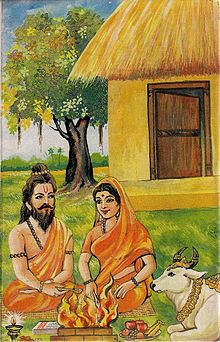วสิษฐ์
วสิษฐ์ (อักษรโรมัน: Vasishtha, สันสกฤต: वसीष्ठ, ไอเอเอสที: Vasiṣṭha) เป็นฤๅษีผู้ทรงพระเวท ที่เก่าแก่และเป็นที่เคารพนับถือมากที่สุดตนหนึ่ง[1][2]ในสัปตฤๅษี (มหาฤๅษีผู้ยิ่งใหญ่ที่ยิ่งใหญ่ทั้ง 7) ของอินเดีย ฤๅษีวสิษฐ์ได้รับยกย่องในฐานะหัวหน้าผู้ประพันธ์ มณฑล 7 ในสมัย ฤคเวท [3] ฤๅษีวสิษฐ์และครอบครัวของเขาถูกกล่าวถึงในกลอนสมัยฤคเวท[note 1] มณฑป ฤคเวทอื่น ๆ และในตำราเวทมากมาย[6][7][8]
| วสิษฐ์ | |
|---|---|
 ภาพของฤๅษีวสิษฐ์ กับภรรยา และโคของเขา | |
| ส่วนเกี่ยวข้อง | สัปตฤๅษี |
| ข้อมูลส่วนบุคคล | |
| คู่ครอง | อรุณธตี |
| บุตร - ธิดา | ศักติมหาฤๅษี และบุตรคนอื่นอีกร้อยคน |
โยควาสิษฐะ, วสิษฐสังหิตา มีเนื้อหาเช่นเดียวกับ อัคนิปุราณะ[9] และ วิษณุปุราณะ เป็นผลมาจากเขา เขาเป็นผู้เขียนตำนานมากมาย เช่น เรื่องที่เขามีวัวศักดิ์สิทธิ์ กามเธนุ ไว้ในครอบครอง ผู้ที่สามารถมอบอะไรก็ได้ให้กับเจ้าของของพวกเขา และนันทินีลูกของเธอ เขามีชื่อเสียงในตำนานของชาวฮินดู ว่าด้วยเรื่องราวความขัดแย้งระหว่างเขากับฤๅษีวิศวามิตร[2][10][11] ใน รามายณะ, เขาเป็นปุโรหิตประจำตระกูลของราชวงศ์รคุ และเป็นอาจารย์ของพระรามและพี่น้องของเขา
ประวัติ
แก้ในเพลงสรรเสริญฤคเวท 7.33.9 ฤๅษีวสิษฐ์อธิบายว่าเขาเป็นนักวิชาการที่ย้ายข้ามแม่น้ำสินธุ เพื่อก่อตั้งโรงเรียนของเขา[12] เขาแต่งงานกับอรุณธาติดังนั้นเขาจึงถูกเรียกว่า อรุณธาตินาถ ซึ่งหมายถึงสามีของอรุณธาติ[13] เชื่อกันว่าฤๅษีวสิษฐ์อาศัยอยู่ริมฝั่ง แม่น้ำ ในยุคปัจจุบันคือ อุตตรันชัล ต่อมาภูมิภาคนี้มีความเชื่อในว่าเป็นที่พำนักของฤๅษีวยาส พร้อมกับ พี่น้องปาณฑพ พี่น้องทั้งห้าของ มหาภารตะ[14] โดยลักษณะทั่วไปของเขาถูกเล่าไว้ในตำราฮินดูโบราณและยุคกลางว่าเป็นนักปราชญ์ที่มีขนยาวสลวยที่มัดเป็นมวยอย่างเรียบร้อยโดยม้วนเป็นกระจุกไปทางขวามีเคราหนวดมือจับและ tilak บนหน้าผากของเขา[15]
ในพระไตรปิฎกภาษาบาลี ทีฆนิกาย เตวิชชสูตร อธิบายการสนทนาระหว่างพระโคตมพุทธเจ้ากับนักวิชาการเวทในสมัยพุทธกาลว่า พระพุทธเจ้าทรงเรียกฤๅษี 10 ตนว่าเป็น "บูรพาจารย์" และผู้รวบรวมโองการโบราณที่และสวดในยุคของเขา และในบรรดาฤๅษีทั้งสิบนั้น มีนามของฤๅษีวสิษฐ์อยู่ด้วย (ในภาษาบาลีสะกดว่า วาเสฏฐะ[16]).[17][note 2]
ดูเพิ่ม
แก้หมายเหตุ
แก้- ↑ Kasyapa is mentioned in RV 9.114.2, Atri in RV 5.78.4, Bharadvaja in RV 6.25.9, Vishvamitra in RV 10.167.4, Gautama in RV 1.78.1, Jamadagni in RV 3.62.18, etc.;[4] Original Sanskrit text: प्रसूतो भक्षमकरं चरावपि स्तोमं चेमं प्रथमः सूरिरुन्मृजे । सुते सातेन यद्यागमं वां प्रति विश्वामित्रजमदग्नी दमे ॥४॥[5]
- ↑ The Buddha names the following as "early sages" of Vedic verses, "Atthaka (either Ashtavakra or Atri), Vamaka, Vamadeva, Vessamitta (Visvamitra), Yamataggi, Angirasa, Bharadvaja, Vasettha (Vashistha), Kassapa (Kashyapa) and Bhagu (Bhrigu)"[17]
อ้างอิง
แก้- ↑ James G. Lochtefeld (2002). The Illustrated Encyclopedia of Hinduism: N-Z. The Rosen Publishing Group. p. 742. ISBN 978-0-8239-3180-4.
- ↑ 2.0 2.1 Mariasusai Dhavamony (1999). Hindu Spirituality. Gregorian. pp. 50 with footnote 63. ISBN 978-88-7652-818-7.
- ↑ Stephanie Jamison; Joel Brereton (2014). The Rigveda: 3-Volume Set. Oxford University Press. pp. 1681–1684. ISBN 978-0-19-972078-1.
- ↑ Gudrun Bühnemann (1988). Pūjā: A Study in Smārta Ritual. Brill Academic. p. 220. ISBN 978-3-900271-18-3.
- ↑ Rigveda 10.167.4, Wikisource
- ↑ "according to Rig Veda 7.33:11 he is the son of Maitravarun and Urvashi" Prof. Shrikant Prasoon, Pustak Mahal, 2009, ISBN 8122310729, ISBN 9788122310726. [1]
- ↑ Rigveda, แปลโดย Ralph T.H. Griffith,
A form of lustre springing from the lightning wast thou, when Varuṇa and Mitra saw thee;
Tliy one and only birth was then, Vashiṣṭha, when from thy stock Agastya brought thee hither.
Born of their love for Urvasi, Vashiṣṭha thou, priest, art son of Varuṇa and Mitra;
And as a fallen drop, in heavenly fervour, all the Gods laid thee on a lotus-blossom - ↑ Maurice Bloomfield (1899). Atharvaveda. K.J. Trübner. pp. 31, 111, 126.
- ↑ Horace Hayman Wilson (1840). The Vishńu Puráńa: A System of Hindu Mythology and Tradition. Oriental Translation Fund of Great Britain and Ireland. p. xxxvi.
- ↑ Horace Hayman Wilson (1840). The Vishńu Puráńa: A System of Hindu Mythology and Tradition. Oriental Translation Fund of Great Britain and Ireland. p. lxix.
- ↑ Adheesh A. Sathaye (2015). Crossing the Lines of Caste: Vishvamitra and the Construction of Brahmin Power in Hindu Mythology. Oxford University Press. pp. 254–255. ISBN 978-0-19-934111-5.
- ↑ Michael Witzel (1997). Inside the Texts, Beyond the Texts: New Approaches to the Study of the Vedas: Proceedings of the International Vedic Workshop, Harvard University, June 1989. Harvard University Press. pp. 289 with footnote 145. ISBN 978-1-888789-03-4.
- ↑ Gopal, Madan (1990). K.S. Gautam (บ.ก.). India through the ages. Publication Division, Ministry of Information and Broadcasting, Government of India. p. 70.
- ↑ Strauss, Sarah (2002). "The Master's Narrative: Swami Sivananda and the Transnational Production of Yoga". Journal of Folklore Research. Indiana University Press. 23 (2/3): 221. JSTOR 3814692.
- ↑ Edwin Bryant (2003). The Quest for the Origins of Vedic Culture: The Indo-Aryan Migration Debate. Oxford University Press. p. 164. ISBN 978-0-19-516947-8.
- ↑ Steven Collins (2001). Aggañña Sutta. Sahitya Akademi. p. 17. ISBN 978-81-260-1298-5.
- ↑ 17.0 17.1 Maurice Walshe (2005). The Long Discourses of the Buddha: A Translation of the Digha Nikaya. Simon and Schuster. pp. 188–189. ISBN 978-0-86171-979-2.
บรรณานุกรม
แก้- Chapple, Christopher. Introduction. In Venkatesananda (1984).
- Lingat, Robert (1973). The Classical Law of India. University of California Press. ISBN 978-0-520-01898-3.
- Olivelle, Patrick (1999). Dharmasutras: The Law Codes of Ancient India. Oxford University Press. ISBN 978-0-19-283882-7.
- Olivelle, Patrick (2006). Between the Empires: Society in India 300 BCE to 400 CE. Oxford University Press. ISBN 978-0-19-977507-1.
- Atreya, B. L. (1981) [1935)]. The Philosophy of the Yoga Vashista. A Comparative Critical and Synthetic Survey of the Philosophical Ideas of Vashista as presented in the Yoga-Vashista Maha-Ramayan. Based on a thesis approved for the degree of Doctor of Letters in the Banaras Hindu University. Moradabad: Darshana Printers. p. 467.
- Leslie, Julia (2003). Authority and meaning in Indian religions: Hinduism and the case of Vālmīki. Ashgate Publishing. ISBN 0-7546-3431-0.
- Atreya, B. L. (1993). The Vision and the Way of Vashista. Madras: Indian Heritage Trust. p. 583. OCLC 30508760. Selected verses, sorted by subject, in both Sanskrit and English text.
- Vālmīki (2002) [1982]. The Essence of Yogavaasishtha. Compiled by Sri Jnanananda Bharati, translated by Samvid. Chennai: Samata Books. p. 344. Sanskrit and English text.
- Vālmīki (1976). Yoga Vashista Sara: The Essence of Yoga Vashista. trans. Swami Surēśānanda. Tiruvannamalai: Sri Ramanasramam. p. 29. OCLC 10560384. Very short condensation.
- Venkatesananda, S., บ.ก. (1984). The Concise Yoga Vāsiṣṭha. แปลโดย Swami Venkatesananda. Albany: State University of New York Press. ISBN 0-87395-955-8. OCLC 11044869.